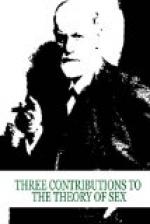Lindner himself has recognized the sexual nature of this action and openly emphasized it. In the nursery thumbsucking is often treated in the same way as any other sexual “naughtiness” of the child. A very strong objection was raised against this view by many pediatrists and neurologists which in part is certainly due to the confusion of the terms “sexual” and “genital.” This contradiction raises the difficult question, which cannot be rejected, namely, in what general traits do we wish to recognize the sexual manifestations of the child. I believe that the association of the manifestations into which we gained an insight through psychoanalytic investigation justify us in claiming thumbsucking as a sexual activity and in studying through it the essential features of the infantile sexual activity.
Autoerotism.—It is our duty here to arrange this state of affairs differently. Let us insist that the most striking character of this sexual activity is that the impulse is not directed against other persons but that it gratifies itself on its own body; to use the happy term invented by Havelock Ellis, we will say that it is autoerotic.[11]
It is, moreover, clear that the action of the thumbsucking child is determined by the fact that it seeks a pleasure which has already been experienced and is now remembered. Through the rhythmic sucking on a portion of the skin or mucous membrane it finds the gratification in the simplest way. It is also easy to conjecture on what occasions the child first experienced this pleasure which it now strives to renew. The first and most important activity in the child’s life, the sucking from the mother’s breast (or its substitute), must have acquainted it with this pleasure. We would say that the child’s lips behaved like an erogenous zone, and that the excitement through the warm stream of milk was really the cause of the pleasurable sensation. To be sure, the gratification of the erogenous zone was at first united with the gratification of taking nourishment. He who sees a satiated child sink back from the mother’s breast, and fall asleep with reddened cheeks and blissful smile, will have to admit that this picture remains as typical of the expression of sexual gratification in later life. But the desire for repetition of the sexual gratification is separated from the desire for taking nourishment; a separation which becomes unavoidable with the appearance of the teeth when the nourishment is no longer sucked in but chewed. The child does not make use of a strange object for sucking but prefers its own skin because it is more convenient, because it thus makes itself independent of the outer world which it cannot yet control, and because in this way it creates for itself, as it were, a second, even if an inferior, erogenous zone. The inferiority of this second region urges it later to seek the same parts, the lips of another person. ("It is a pity that I cannot kiss myself,” might be attributed to it.)




